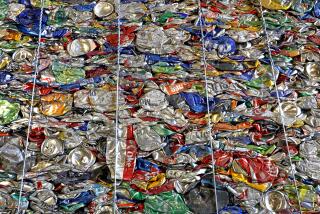2nd Chance : Feelings Mixed on Bill Before Wilson to Give Cities Extra Time to Meet Recycling Goal
As Orange Countyâs cities scramble to meet a state deadline to recycle 50% of their trash by the year 2000, some are balking at new legislation to grant extensions, while others say the proposed law would correct past problems.
Both houses of the Legislature have unanimously voted in recent weeks to allow cities that can prove they are making a âbest faith effortâ to have up to five extensions--until 2006 if necessary--to obey the law. The bill awaits Gov. Wilsonâs signature.
âWe always knew that 50% by the year 2000 would be a formidable challenge . . . so we agreed to give the state waste board some authority to make extensions,â said state Sen. Byron Sher (D-Stanford), who sponsored the original bill in 1989 and the current changes.
The 1989 bill called for penalties of up to $10,000 a day for those who did not meet the deadline, which Sher acknowledged was âa huge sword hanging over citiesâ heads. The idea is to provide reasonable flexibility.â
Critics say the proposed changes in state law are unfair to some cities, like Huntington Beach, which has spent millions on recycling and is already diverting 46% of its trash.
âThat I resent, because cities who have been putting in the effort and the extra expense are being penalized,â said Ron Shenkman, senior vice president of Rainbow Disposal Inc.
Huntington Beach and Fountain Valley residents are paying for Rainbowâs construction of an $11-million materials recycling facility, which will allow both communities to meet the 50% mark well before the year 2000, Shenkman said.
âWe provide a top-notch diversion service; weâve done what we were supposed to,â he said.
But officials in cities such as Irvine and Laguna Beach say the extensions are good news. They say they were aggressively recycling years before the 50% state mandate went into effect in 1990 and had been punished for being good environmental citizens.
They argue, and county waste management officials agree, that they received no credit for the amount recycled before 1990, so they are in fact recycling far more than cities who just began a few years ago.
âI welcome the changes,â said Mike Byrne, a city of Irvine senior analyst. âIt makes for a more fair system that recognizes the differences in every city. . . . Since our program started in 1987, it is harder to cut that much more. If you had no program at all before 1990, itâs really easier for you to reach your mandate.â
Overall, Orange County is well on its way to making the 50% goal--an average 34% of all citiesâ garbage is being diverted from landfills, according to the county Department of Integrated Waste Management.
But the rates of recycling reported by the 31 individual cities vary widely. Seal Beach, for instance, leads the list with 64% of all its garbage being diverted, while San Juan Capistrano is 26% below its 1990 amount.
San Juan Capistrano officials and others say the numbers are wrong, because the method devised for measuring recycling was flawed from the beginning. They applaud the legislative changes.
âThe figures are absolutely useless,â said Kenneth C. Frank, the city manager of Laguna Beach, which has diverted a reported 20% of its trash since 1990. âThereâs going to have to be extensions, because very few people are going to meet that deadline.â
*
County staff admit there were no scales in place at landfills in 1990 to weigh garbage trucks and their loads, meaning the amounts of garbage allocated to each city that year were, in many cases, estimates.
Another problem is the formula developed by a UCLA professor and adopted by the state Integrated Management Board to determine the percentage of trash being diverted. The formula calls for including demographic information that has no relevance to garbage collection, local officials said, and leads to skewed numbers.
Douglas Dumhart, senior management analyst for San Juan Capistrano, said the formula simply did not work for cities like his. Records kept by the cityâs hauler, Solag Disposal, show that 36.9% of San Juan Capistranoâs trash is being kept out of landfills. But when the cityâs numbers were plugged into the state formula, it showed they were recycling 26% below the 1990 amount.
âWe have no problems with our recycling system,â Dumhart said. âWe have a problem with the state formula.â
Lanny Clavasella, a spokesman for the state board, conceded âthere have been some problems with calculating rates. . . . Weâve worked with jurisdictions to clean up some of the math.â
Environmental lobbyists said it was problems with the numbers, as well as political pressure to scrap the 50% mandate entirely, that prompted this monthâs legislation.
Aside from the calculation problems, many cities that found it fairly easy to recycle a quarter of their waste are finding it much harder to cut half.
The answer to that dilemma may be as close as peopleâs backyards. Orange County landfill disposal records show that up to a third of the waste stream is actually grass clippings and other âgreenâ waste. Seal Beach and other cities that have had green-waste collection programs in place for a year or more have successfully reached the 50% mark.
âYou canât meet the 50% without doing some sort of green waste recycling,â said Michael Carey, who runs the countyâs oldest recycling center at Orange Coast College. âItâs just the easiest way to do it; thereâs not enough other kinds of waste left.â
Even 50% wonât be enough for some, however.
âWe plan on pushing past this legislation. The notion of zero waste in landfills in the next 20 years is an achievable objective,â said Mark Murray of the environmental lobbying group Citizens Against Waste.
(BEGIN TEXT OF INFOBOX / INFOGRAPHIC)
Separate but Equal
Trash customers in 10 Orange County cities are not required to separate any garbage for recycling. In the other 21 cities, residents must sort their trash before putting it at curbside. The percentage of trash diverted from landfills varies. How the cities compare: *--*
Monthly City rate Separate? % Diverted* Anaheim $14.33 Y 48% Brea 13.81 Y 42 Buena Park 11.28 N 24 Costa Mesa 12.58 N 31 Cypress 13.02 Y 59 Dana Point 13.02 Y 27 Fountain Valley 15.94 N 51 Fullerton 12.30 N 32 Garden Grove 14.35 Y 46 Huntington Beach 16.49 N 46 Irvine 9.92 Y 17 La Habra 12.89 Y 32 La Palma 13.12 N 49 Laguna Beach 11.00 Y 20 Laguna Hills 11.39 Y 38*** Laguna Niguel 13.06 Y 23 Lake Forest 10.47 Y 20 Los Alamitos 12.56 Y 30 Mission Viejo 12.64 Y 43 Newport Beach 12.37 N 42 Orange 10.13 N 26 Placentia 13.96 Y 33 San Clemente 13.17 Y -11** San Juan Capistrano 12.93 Y -26** Santa Ana 13.39 Y 38 Seal Beach 12.25 Y 64 Stanton 13.19 N n/a Tustin 11.74 N 26 Villa Park 14.62 Y 50 Westminster n/a Y 61 Yorba Linda 15.78 Y 46 Unincorporated areas Varies Y/N 42
*--*
* 1995, most recent report
** Cities listing a negative amount were that percentage below the stateâs 1995 mandate. Officials in those cities argue the figures are skewed.
***Laguna Hills, incorporated in 1991, began recycling in 1996.
Source: Individual cities and waste management companies; Researched by JANET WILSON and APRIL JACKSON / Los Angeles Times
More to Read
Sign up for Essential California
The most important California stories and recommendations in your inbox every morning.
You may occasionally receive promotional content from the Los Angeles Times.










